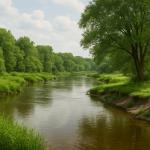What is it?
- Habitats are natural environments where specific plants, animals, and other organisms live.
- They provide the necessary conditions for survival, growth, and reproduction of these organisms.
Types of Habitats
- Terrestrial Habitats: These are land-based habitats like forests, grasslands, deserts, and mountains.
- Aquatic Habitats: These include freshwater habitats like rivers, lakes, and ponds, as well as marine habitats such as oceans and seas.
- Aerial Habitats: Some organisms, particularly birds and insects, live primarily in the air, though they rely on land or water for nesting and feeding.
- Artificial Habitats: Human-made environments such as urban areas, agricultural fields, and aquaculture farms.
Factors Affecting Habitats
- Climate: Temperature, humidity, and weather patterns play crucial roles in defining a habitat.
- Geography: The physical features like mountains, valleys, and water bodies.
- Flora and Fauna: The types of plants and animals found in a habitat.
- Adaptations: Organisms develop specific traits to survive in their particular habitats.


